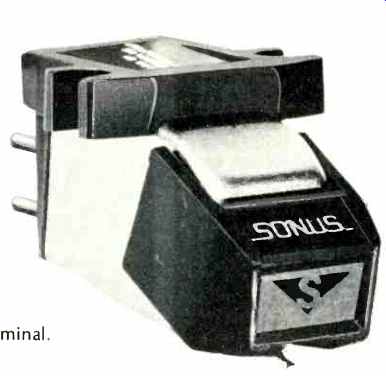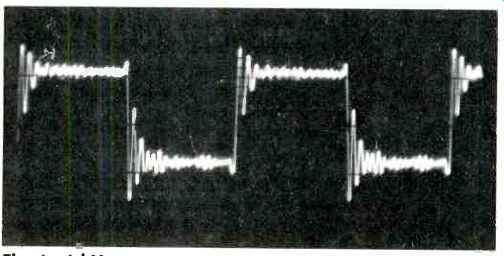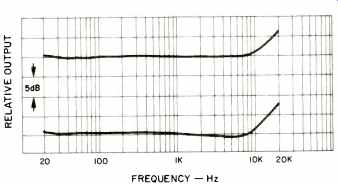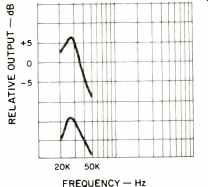
MANUFACTURER'S SPECIFICATIONS:
Frequency Response: 5 Hz to 20 kHz ±1.5 dB.
Voltage Output at 1 kHz/cm/sec: 0.8 mV ±2 dB.
Compliance: 50cros/dyne x 10^-6.
Stylus Force Range: 0.75 to 1.25 grams.
Vertical Tracking Angle: 20 degrees nominal.
Channel Balance: 2 dB.
Nominal Channel Separation at 1 kHz: 30 dB.
Recommended Load Impedance per Channel: 47 kilohms resistance in parallel with not more than 400 pF. When used for CD-4, capacitance should not exceed 250 pF.
Cartridge Weight: 5 1/2 grams.
Price: $125.00; replacement stylus, $62.00.

Fig. 1--1 kHz square wave response of the SONUS Blue Label.
The SONUS cartridge is available in three models, the Blue Label, tested here, with a multi -radial stylus; the Red Label, with a elliptical (bi-radial) stylus, and the Green Label with a spherical stylus. The choice of stylus determines the model since all three models utilize a common cartridge body. Our review is restricted to the Blue Label cartridge with the multi-radial stylus, which incidentally is capable of playing Quadradisc records.
When we first listened to this cartridge, we were impressed by the sound emanating from our speakers; this obviously wasn't an average cartridge. During the 10 hours of listening we normally do prior to measuring a cartridge, we became acutely aware of the fact that this was an exception ally good cartridge. Continued listening convinced us that Peter E. Pritchard has indeed developed a cartridge that is superior to all his previous designs.
The SONUS Blue Label certainly ranks among the best cartridges we have tested for stereo, SQ, QS, CD-4, and UD-4. The audiophile in search of a cartridge to play all types of recording formats should seriously consider the SONUS Blue Label cartridge for this purpose.
Measurements
The manufacturer's specifications recommend an input impedance of 47 k-ohms per channel, paralleled by no more than 400 pF, and for CD-4 use no more than 250 pF capacitance. We made all of our measurements using a 100-kohm load and less than 100 pF capacitance, since the Sonus Blue Label is meant to be used for reproducing CD-4 records. Because CD-4 demodulators have a 100-kohm load resistor in each magnetic phono input channel and their recommended phono cable input capacitance is less than 100 pF, it appeared most appropriate to make measurements under the actual loading conditions present at the demodulator. The maker informs us his measurements were made with a 47kohm load, since they feel most set ups will have such a load with only CD-4 requiring the 100-kohm load. The measured response should then be flatter above 10 kHz, though beginning to rise slowly.
The frequency response of the cartridge, using the B & K QR-2009 test record, is ±1.5 dB from 20 Hz to about 13 kHz and +6.25 dB at 20 kHz at an optimum tracking force of 1.25 grams and anti-skating at 2 grams. Separation generally averages 20 dB through 14 kHz and 18.5 dB at 20 kHz. Checking the frequency response above 20 kHz with the JVC TRS-1005 test record, the cartridge has a peak of +7 dB at approximately 28 kHz and then drops to +5 dB at 30 kHz and -5 dB at 40 kHz. Separation at these high frequencies is excellent, e.g. 19 dB at about 28 kHz, 18 dB at 30 kHz, and 15 dB at 40 kHz. From these data, one can conclude that the cartridge has an excellent frequency response and separation for stereo, matrixed four channel, as well as discrete quadraphony.
This proved to be the case, especially for discrete quadraphony where we encountered no difficulty in locking the cartridge to either a CD-4 or UD-4 demodulator.
Although the square-wave response at 1 kHz shows a fair amount of ringing present, the frequency of the undamped peak in the carrier range is beyond hearing. Using the Audio-Technica AT -1009 arm, the cartridge -arm low-frequency resonance was less the 10 Hz.
As is our practice, measurements are made on both channels, but only the left channel is reported. During the test period the average temperature was 70°F ±1° (21°C) and the relative humidity 61 percent ±3 percent.
The following adjustment and test records were used in making the reported measurements: Technics MA -4009; Micro-Acoustics TT2002; Shure TTR-103, TTR-109, TTR-110; Columbia STR-100, STR-112, SQT-1100; JVC TRS-1004, IRS 1005; Stereo Review SR -12; B & K QR-2009; Deutsches Hi Fi No. 2; Denon (UD -4) ST -5003; Ovation OVQS/4000, and Nippon Columbia Audio Technical Records (Pulse Code Modulation) XL -7004-6.
Wt. 5.52 g; d.c. res. 214.7 ohms; ind. 145 mH; opt. tracking force, 1.25 g; opt. anti-skating force, 2 g; output, 0.875 mV/1 cm/sec; IM dist. (4:1) + 9 dB lateral, 200/4000: 1.2%= + 6 dB vertical, 200/4000: 4.21/4; crosstalk, -28 dB; ch. bal., 0.25 dB; trackability: high freq. (10.8 kHz pulsed), 24 cm/sec; mid-freq. (1000 + 1500 Hz lat. cut), 25 cm/sec; low freq. (400 + 4000 Hz lat. cut), 19 cm/sec; 30 kHz mono signal, 2.2 mV; Deutsches Hi Fi No. 2: 300 Hz test bands tracked to 67 microns (.0067 cm) horizontal and 20.6 microns (.00206 cm) vertical; passed all bands of the Shure TTR-110 (Era Ill) test record; tracks warped records without difficulty. Passed all bands of the Micro-Acoustics Transient and Tracking test record.
Listening Evaluation
Since one does not listen to laboratory measurements, it is important to perform a cartridge listening evaluation by listening to a wide variety of recordings over a reasonable length of time. While listening to the various records played with the SONUS Blue Label cartridge, we noted the fine definition of the individual instruments, good sonic clarity, excellent transient response and applause definition, superb bass response, and a tracing and tracking ability which was exceptionally good. All this in spite of the odd rise from about 10 kHz to about 28 kHz in the frequency response curve. It shows that there are factors in phonograph record reproduction which we do not yet understand.

Fig. 2--Amplitude-frequency response and separation from 20 Hz to 20 kHz
using B&K QR-2009.

Fig. 3--Amplitude-frequency response and separation from 20 to 50 kHz using
JVC TRS-1005.
As is the case with numerous records today, many of those we used in our listening evaluation exhibited various degrees of warpage. Particularly annoying is the prevalence of dish warpage. Others have such noisy surfaces that they are difficult to use in a listening evaluation. The problem isn't only of domestic origin since we find many of the foreign labels to be plagued by the same problems. We wonder if the time will ever come when the majority of records will be available without warp and with quiet surfaces.
The following equipment was used for the listening evaluation: Technics SP-10 turntable, Audio-Technica AT-1009 tone arm, two Phase Linear 4000 preamplifiers, Crown DC 300A amplifier for the front channels and Crown D-150 amplifier for the rear channels, two Duntech DL-15B speakers for the front channels and two Cerwin-Vega 211 (R) speakers for the rear channels, and two Janis Audio Associates W-1 subwoofers along with a Crown VFX-2 crossover network. The matrix quadraphonic decoders used were the Lafayette SQ-W, the Sansui QSD-1, and the SQ and QS positions of the Denon UDA-100. The CD-4 demodulator was the Technics SH-400 and the UD-4 demodulator was the Denon UDA-100.
As is our practice, a rigorous listening evaluation was conducted utilizing the records listed in our reports in Audio, September 1975, November 1975, and January 1976 and the following excellent recordings which demonstrate quite effectively the ability of the SONUS Blue Label cartridge to reproduce difficult recordings faithfully. All records were cleaned with the Keith Monks Record Cleaning Machine and/or the Discwasher and destaticized with the Zerostat.
Although we list records in the various quadraphonic formats, all of them are compatible and may be played without exception as stereo recordings.
Stereo
Michael Murray: Dupre-Organ Recital; Advent Records 5014 Stravinsky: The Rite of Spring-Vienna Philharmonic Orchestra; Maazel, London CS6954 Handel: Overtures and Sinfonias; London CSA 2247 Stanely Clarke: Journey to Love; Nemperor Records NE 433 Earthquake: Special Sound Effects; MCA -2081 Percussion Music; Nonesuch H-71291 Virgil Fox Plays the Classics-Heavy to Light; Angel S-36052 Orff: Carmina Burana; Royal Philharmonic Orchestra, Dorati, London SPC 21153
Direct-to-Disc Recording (Stereo)
Rough Trade: Live!; Umbrella UMB DD1 (This recording is superb and may be obtained only through your local Audio-technica dealer.) Pulse Code Modulation Recording (PCM) (Stereo)
Virtuosos For Strings; Sofia Chamber Orchestra, Kasandjiev, Denon PCM OX-704ND
SQ
George Gershwin Plays Rhapsody in Blue; Thomas, Columbia XM34205 Concert of the Century Recorded Live at Carnegie Hall; Columbia M2X 34256 Massenet: Thais; Angel SCLX 3832 Karajan Conducts Wagner-Album I; Angel S-37097 O'Jays: Message in the Music; Columbia PZQ 34245 QS
David Liebman: Sweet Hands; A & M (Horizon 2) SP -702 The Winds of Alamar by Iguana; Quadratrak A 101 Rufus: Rags to Rufus; ABC CDQ 40024 Tchaikovsky: The Complete Orchestral Music-Volume II; Vox QSVBX 5130 CD-4
Tomita: Firebird; RCA ARD1-1312 Mancini: Symphonic Soul, RCA APD1-1025
The Drum Session: Philips 4 DX -52-3 Stowkowski Conducts Mahler-Symphony No. 2 ("Resurrection"); RCA ARD2-0852
The SONUS Blue Label cartridge reproduced all of the above records exceptionally well and without any noticeable coloration. Organ music, particularly the bass pedal notes, is reproduced with a weight and solidity which is quite outstanding. For exceptionally good bass, the first two bands of side one of the Stanley Clarke recording are exceptional. Not every cartridge can reproduce the Percussion Music, Earthquake: Special Sound Effects, and The Drum Session records cleanly in their entirety. The Stravinsky: Rite of Spring recording will give any cartridge a real workout. In the fiendishly difficult final passages of the work, with its high amplitudes and velocities in the inner grooves, the record was tracked by this cartridge with absolute ease. The direct-to-disc recording is of rock music and is a superb disc with very quiet surfaces. Voice reproduction with the SONUS Blue is extremely good, as evidenced by the Massenet: Thais recording. The Pulse Code Modulation (PCM) recording is the new direction of recording technology. Using a 13-bit natural binary code, the master tape has a wide dynamic range, exceeding 85 dB, very low distortion, and crosstalk of -80 dB. In the very near future, more releases will be available in the PCM format. This type of mastering results in a superior analog disc recording, as is evident from the sound of these records.
In summation, we were quite impressed with the SONUS Blue Label cartridge. It is a cartridge that does not cause fatigue during extended listening sessions, a factor which reflects the technical excellence of the design. For the discerning music lover, this cartridge merits their serious consideration.
--B.V. Pisha
(Source: Audio magazine, Apr. 1977)
Also see:
Sonus Gold Series II Blue Label Phono Cartridge (Jul. 1979)
Sonus Dimension 5 Cartridge (Mar. 1982)
Dual Model 1249 Automatic Turntable (Feb. 1977)
ADC Model LMF-2 Tonearm & ZLM Phono Cartridge (Jan. 1979)
= = = =